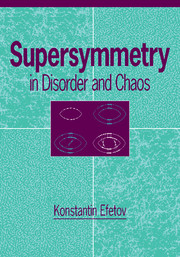Book contents
- Frontmatter
- Contents
- Preface
- Acknowledgments
- 1 Introduction
- 2 Supermathematics
- 3 Diffusion modes
- 4 Nonlinear supermatrix σ-model
- 5 Perturbation theory and renormalization group
- 6 Energy level statistics
- 7 Quantum size effects in small metal particles
- 8 Persistent currents in mesoscopic rings
- 9 Transport through mesoscopic devices
- 10 Universal parametric correlations
- 11 Localization in systems with one-dimensional geometry
- 12 Anderson metal–insulator transition
- 13 Disorder in two dimensions
- 14 Afterword
- Appendix 1 Calculation of the Jacobian
- Appendix 2 Magnetic field parametrization
- Appendix 3 Density–density correlation function at k = 0
- Appendix 4 Effective medium approximation as a saddle point
- References
- Author index
- Subject index
7 - Quantum size effects in small metal particles
Published online by Cambridge University Press: 10 November 2010
- Frontmatter
- Contents
- Preface
- Acknowledgments
- 1 Introduction
- 2 Supermathematics
- 3 Diffusion modes
- 4 Nonlinear supermatrix σ-model
- 5 Perturbation theory and renormalization group
- 6 Energy level statistics
- 7 Quantum size effects in small metal particles
- 8 Persistent currents in mesoscopic rings
- 9 Transport through mesoscopic devices
- 10 Universal parametric correlations
- 11 Localization in systems with one-dimensional geometry
- 12 Anderson metal–insulator transition
- 13 Disorder in two dimensions
- 14 Afterword
- Appendix 1 Calculation of the Jacobian
- Appendix 2 Magnetic field parametrization
- Appendix 3 Density–density correlation function at k = 0
- Appendix 4 Effective medium approximation as a saddle point
- References
- Author index
- Subject index
Summary
Small metal particles
General properties
Small clusters of atoms of metallic elements have very unusual physical properties. These objects are not as small as molecules and some of their properties are reminiscent of those of bulk metals. At the same time the electron spectrum is discrete and this has many intriguing consequences. Systems of small metal particles are under very intensive study, and some of their characteristics have various technical applications. However, the physical properties of the metal clusters are no less interesting than possible applications because to describe them one needs modern quantum statistical theories analogous to those developed in nuclear physics. Moreover, some approaches invented studying the metal particles have their applications in nuclear physics and problems of quantum chaos. A complete account of experimental and theoretical results can be found in the review by Halperin (1986). An impression of the state of the art of both the experimental and the theoretical work can be gained from the proceedings of the Fourth International Meeting on Small Particles and Inorganic Clusters (Chapon, Gillet, and Henry (1989)). Some aspects of small particle physics are considered in recent reviews by Staveren, Brom, and de Jongh (1991) and Nagaev (1992).
Following the main idea of this book in this section I want to discuss several important steps in the theoretical understanding of the systems of small metal particles; then in the following sections of this chapter I present results obtained by the supersymmetry technique.
- Type
- Chapter
- Information
- Supersymmetry in Disorder and Chaos , pp. 119 - 151Publisher: Cambridge University PressPrint publication year: 1996

